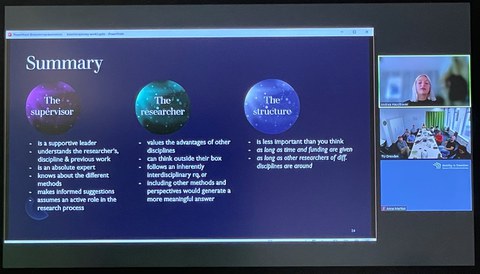Sep 13, 2022
Experiences of interdisciplinary work at UC Davis, USA
On August 8th, 2022, the former doctoral student of the 3rd Boysen-TU Dresden Research Training Group, Ms Andrea Hauslbauer (Project C3: Analysis of User Behavior Adjustments for New Mobility Concepts), was a virtual guest at the RTG. Ms Hauslbauer was a member of the 3rd generation of the Research Training Group from March 1st, 2019 to February 28th, 2022 and during this time spent a semester abroad at the University of California, Davis, USA as part of the Institute of Transportation Studies (the Research Training Group reported). Focusing on how interdisciplinarity was lived there, Ms Hauslbauer shared many helpful experiences with the doctoral students in her report.
First, Ms Hauslbauer introduced the presentation with the definitions of interdisciplinarity, multidisciplinarity and transdisciplinarity. She quoted from literature sources why the implementation of interdisciplinary work in the research environment is often a challenge: most scientists concentrate on their field of expertise in their work, which makes it much more difficult to benefit other disciplines. Ms Hauslbauer summarised according to her own experience that common goals and methods are crucial and immensely important for a common benefit. In the second part of her presentation, Ms. Hauslbauer pointed out from her experience at UC Davis the importance, in her opinion, of the roles of the academic supervisor, the researcher him/herself and the organisational structure for the quality of interdisciplinary research.
She sees the active role of the supervisor as being of the utmost importance. Motivation, appreciation, absolute expertise in one's own subject area, but also comprehensive knowledge of other subject areas and of working methods are necessary for this. The researchers themselves must have the will and the ability to work in a concentrated manner towards a common goal with other researchers, to show interest in disciplines outside their own field and to think outside the box. Last but not least, the right environment, time and space for organisational issues and discussions are essential. In their opinion, the organisational structure is then of secondary importance for interdisciplinary work - once all the aforementioned prerequisites have been created.
The Boysen-TUD-Reserach Training Group would like to sincerely thank Ms Hauslbauer for this interesting and descriptive lecture and wish her continued success in her interdisciplinary research work and in her professional life.

